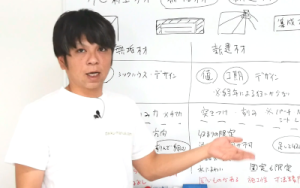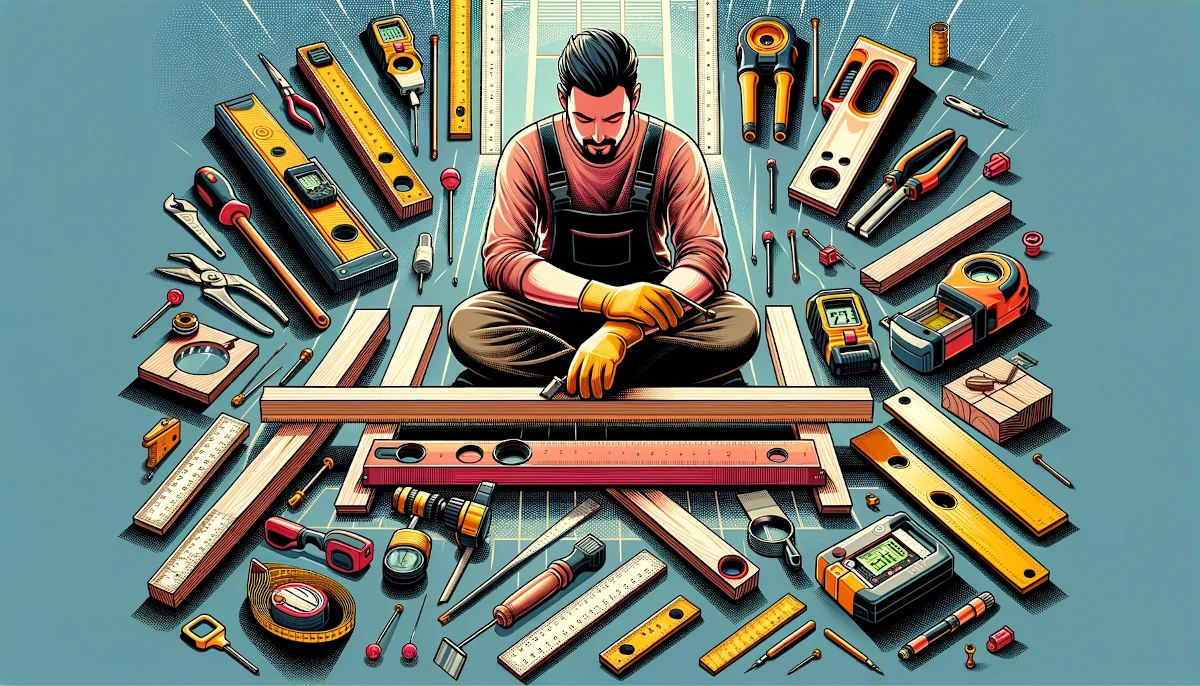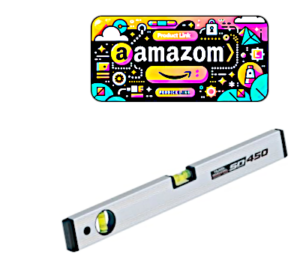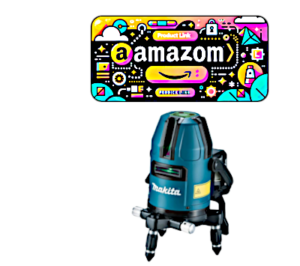In carpentry work, measurements such as horizontal and vertical alignments are essential. Carpenters use a variety of tools related to horizontal and vertical measurements, including rulers, plumb bobs, levels, water tubes, and laser levels, among others. By selecting the appropriate tool for the task, construction efficiency can be significantly improved.
In this article, we’ll explore the features and selection strategies of marking and measuring tools used by Japanese professional carpenters in recent renovation and construction projects.
Furthermore, we’ll also introduce some cost-effective tools that come highly recommended. Please consider them for your next project.
This page contains promotional content.
日本語版の記事(水平・垂直の墨出し道具【まとめ】レーザー墨出し機などの使い方)はコチラ
List of Contents
Article Author

Kentarou Fukata
A Kyoto, Japan native born in 1985, I am a seasoned carpenter boasting five national qualifications in housing-related disciplines in Japan. Committed to the dissemination of carpentry expertise, I actively contribute to professional development within the field through instructional content on YouTube.
Introduction Video
Complementing the guide is an informative video designed to augment comprehension.
If you wish to utilize features like subtitles, please reopen the video on YouTube. You can access the subtitles through the ‘CC’ button on the playback screen or in the settings.
In carpentry, ensuring horizontal and vertical alignment
First, let’s organize the situations in carpentry work where checking for horizontal and vertical alignment becomes necessary.
Renovation Wall Construction
n renovation projects involving wall construction, correcting a warped wall requires selecting a construction method suited to the situation from the following three options:
Utilizing the existing wall and applying new wall material
This method is chosen to keep costs low while preserving the finished room’s internal dimensions.
Correcting or reconstructing the base of the existing wall
Opt for this when aiming to create a flat wall while maintaining the finished dimensions.
Building a new wall inside the existing wall
This is done to accommodate utility piping and wiring within the wall and to construct a vertical wall.
Checking for levelness in new construction
In Japanese new construction, the establishment of floor levels heavily relies on the foundation. However, deviations of a few millimeters can occur, necessitating points in the carpentry work where levelness must be re-established.
Levelness of Ceiling Framework
For ceilings, although it’s possible to construct them at uniform heights from the floor, re-establishing levelness enhances workability.
Horizontal and Vertical Alignment in Staircase Construction
Staircases, often pre-fabricated, require precise installation, necessitating checks for horizontal and vertical alignment and adjustments down to the millimeter.
Shelves and Windows
For horizontal constructs like shelves and windows, which are at eye level, discrepancies can be easily noticed in daily life, especially once furniture is placed.
Setting Right Angles in Carpentry
In carpentry, it’s essential to establish right angles in the horizontal plane. For new constructions, this crucial step of setting the right angles is carried out during the foundation laying, which is the initial phase of the project.
In the case of renovations or custom constructions in apartments, setting the right angle serves as the foundational baseline at the very start of the work.
Types and Characteristics of Tools for Vertical Alignment
Aluminum Rulers (1m to 2m)
Aluminum rulers, commonly seen as rod-shaped tools, are particularly useful in carpentry, with lengths around 2 meters being especially beneficial. There are two main types: a thin and flexible variety, and a square, tubular version that does not bend, even in the direction of its thickness. The non-bending type is preferred for measurements, as it reliably maintains its shape. Similar to the use of a string line, its purpose is to verify straightness. Unlike string lines or laser levels, aluminum rulers are applied directly to the working surface, making it possible to detect deviations that are difficult to spot with the naked eye.
When handling aluminum rulers, due to their length and rigidity, it is essential to be cautious to prevent them from falling or damaging materials with their edges.
String Line (Line Reel)

A string line, much like a ruler, is a tool designed for verifying straightness. Its advantage over conventional rod-shaped rulers is its adjustable length, making it particularly adept at measuring long spans.
The string line requires careful handling to avoid contact during use, as touching it can compromise its accuracy. Additionally, similar to the “Sumitsubo,” it utilizes a “Karuko” equipped with a needle, necessitating cautious handling to ensure precise measurements.
Plumb Bobs
A plumb bob is a tool designed to check vertical alignment by suspending a weight on a string. It possesses a structure that does not physically distort, making it a tool of unparalleled accuracy used since ancient times.
For measurement, it is essential to bring the string and weight to a halt, with heavier weights being more user-friendly for this purpose. The weight’s tip is pointed to facilitate the identification of the string’s core, necessitating caution against dropping it. Additionally, when used outdoors, it is important to be mindful of the influence of crosswinds.
It’s advisable to develop a habit of checking the suspension point dimension when using the tool, as the fixed body’s point of suspension may shift during measurement.
While laser levels have become widespread for similar applications, the plumb bob, with its convenience and portability, remains a frequently used tool even today.
Water Leveling Tubes
Water leveling tubes are measuring devices that utilize a transparent tube filled with water to determine levelness by comparing the height of the water surface on both sides. Like the plumb bob, this method offers high precision without physical distortion. However, with the advent of laser levels, which can quickly measure horizontality, their use in recent construction work has diminished.
Although laser levels are more expensive, considering the cost of tube hoses, this method is recommended for DIY horizontal checks.
Spirit Levels
A spirit level is a measuring tool that consists of a rod-shaped body equipped with a transparent tube containing a bubble, which is used to determine horizontal and vertical alignments. While spirit levels offer a quick way to check alignments, their use in carpentry is minimal due to low precision and limitations in measurable length.
They are convenient for mounting small items. However, as precision instruments, spirit levels are surprisingly delicate and prone to losing accuracy through impacts like falls or knocks. Considering the need to keep various lengths on hand to remain useful, their cost-effectiveness is questionable.
Laser Levels
Laser levels are devices capable of projecting laser lines horizontally, vertically, in straight lines, and at right angles, allowing for the simultaneous verification of all directional accuracies. They enable planar verification in space, facilitating construction procedures that were once impossible.
In new construction, they are used for verifying the horizontality of ceilings and fabrications, and for setting right angles in foundation layouts. In renovation groundwork, laser levels set the standard in almost every step.
A critical consideration when handling laser levels is their sensitivity to vibrations, which can easily compromise their accuracy. Care must be taken not to drop the device and to minimize transportation by vehicle as much as possible. The cost of repairs can be high, and adjustments or repairs can be time-consuming, making it one of the most delicately handled tools in carpentry.
The accuracy of a laser level cannot be judged by feel alone. Setting standards with a misaligned laser level can lead to difficult corrections later, necessitating accuracy checks against a plumb bob before use.
Furthermore, laser levels pose potential risks to human health. Direct exposure to laser beams can severely damage the eyes, potentially leading to rapid vision loss. It is imperative never to look directly into the laser beam.
Selecting the Appropriate Measuring Tools for Carpentry
In carpentry, it’s essential to choose the most efficient tool based on its unique features. Below is a summary of key points for differentiating the use of these tools.
Key Points in Selecting Measuring Tools for Carpentry Work
The selection of measuring tools in carpentry involves using the laser level as a benchmark to compare the features of other tools and decide which one to use. While it is possible to conduct all verification work with a laser level, its delicate nature means that accuracy can be compromised by a single fall. Therefore, it is used exclusively for tasks that cannot be done with other tools or where using another tool would result in inefficiency.
For level checks, water levels are avoided due to their poor portability and immediacy, with laser levels being used for all such verifications.
When to Use an Aluminum Ruler
When adjusting the straightness of finish carpentry materials, checking for unevenness on surfaces during planing or milling, or verifying the straightness of a substrate’s surface during work, an aluminum ruler is used to assess the straightness and degree of unevenness on surfaces.
When to Use a String Line
A string line is utilized for adjusting the straightness of substrates, setting the initial straight line for laying flooring materials, and establishing reference lines in outdoor work where laser light may be difficult to see, also for verifying straightness. The difference from an aluminum ruler is the flexibility in the length of line that can be checked and, conversely, the lower ability to measure surface flatness. A distinctive feature of both tools is their ability to be used without being confined to horizontal or vertical orientations.
When to Use a Plumb Bob
The use of a plumb bob is limited, primarily for verifying the verticality of posts and beams in new construction. For other vertical checks, a laser level is used. This is because vertical verification requires checking both forward/backward and left/right directions simultaneously, and the ability of laser levels to measure in two directions at once makes them more efficient. However, in new construction, when verifying the verticality of posts, the poor footing conditions may make it undesirable to bring in a laser level, thus opting for a plumb bob.
When to Use a Spirit Level
The spirit level is employed for tasks requiring high planarity, such as installing small, flat items, and during construction on external scaffolding. Due to its lower precision and versatility, its use is limited to specific situations where its features can be fully utilized. In external scaffolding work, where bringing in a laser level is not feasible, a spirit level becomes an invaluable tool for level verification.
Checkpoints for Selecting Different Measuring Instruments
Choosing an Aluminum Ruler
The criteria for selecting an aluminum ruler differ based on whether it is being used as a cutting guide or for measuring straightness. For straightness measurements, it’s essential that the ruler does not bend, not just laterally but also in terms of thickness. A 1m long ruler can serve both purposes, but a 2m cutting guide is not suitable for measuring straightness. For a 2m length, a cylindrical type measuring approximately 15mm x 50mm is recommended.
Choosing a String Line (Line Reel)
In carpentry and construction work, automatic winding line reels are user-friendly. However, since tightening the spring on automatic reels can be cumbersome, it’s also advisable to have a manual winding reel ready for outdoor tasks or projects that span a longer duration.
Selecting a Level
In carpentry, there’s rarely a need for a level shorter than 20cm. A single level of around 50cm in length should suffice for most tasks.
Choosing a Laser Level
Considerations for Repair and Maintenance
Laser levels necessitate regular maintenance and adjustments, highlighting the importance of easy access to repair services. It’s recommended to opt for a purchase from a nearby tool shop that facilitates straightforward repair requests.
Laser Direction and Its Impact on Efficiency
The efficiency of your work is greatly influenced by the laser beam’s range. Selecting a laser level that matches the scope of your projects can significantly enhance productivity.
Horizontal Maintenance Mechanisms: A Comparative Overview
Laser levels are equipped with mechanisms to maintain horizontality, such as electronic gimbals, which are robust against vibrations, and pendulum types, which are more budget-friendly. Your choice should align with the specific conditions under which you’ll be using the device.
Exploring Additional Features
Various models boast unique features, including automatic rotation via remote control and beams that narrow with distance. Moreover, laser levels are available in different beam colors, like red and green, offering options to suit diverse preferences and requirements.
Pricing Trends for Laser Levels
The cost of laser levels has become more affordable over time, with professional-grade models now available around the 50,000 yen price point, making advanced tools more accessible.
Choosing the Right Stand for Laser Levels
While tripods are commonly used for height adjustment, they might not always be convenient for carpentry work due to space constraints. Stands designed to clamp onto columns present a practical alternative, ensuring your workspace remains uncluttered.
Conclusion
Did you find any useful information regarding the tools for measuring horizontally and vertically? The choice of measurement method can significantly affect construction efficiency. By understanding the characteristics of each tool, you may be able to master innovative construction procedures. Therefore, I encourage you to experiment with the tools you have to find the best method.







“How to Use Laser Levels and Plumb Bobs | A Skilled Craftsman’s Gentle Guide to Tools for Vertical Alignment” への1件のフィードバック
Ace of Base — шведская поп-группа, образованная в 1990 году. Их музыкальный стиль сочетает в себе элементы поп-музыки, дэнса и электроники. Группа стала популярной благодаря хитам “All That She Wants”, “The Sign”, “Don’t Turn Around” и “Beautiful Life”. Эти композиции не только покорили чарты во многих странах мира, но и остаются классикой жанра до сих пор. Ace of Base оставили неизгладимый след в истории поп-музыки, их мелодии до сих пор радуют слушателей по всему миру. Скачать музыку 2024 года и слушать онлайн бесплатно mp3.